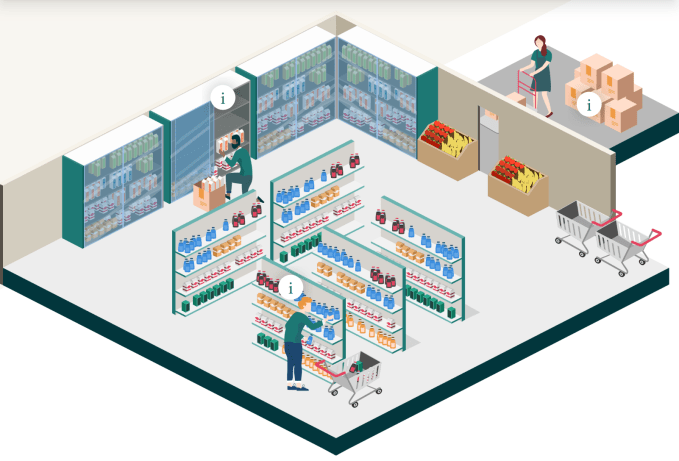Fundings & Exits
Auto Added by WPeMatico
Auto Added by WPeMatico
Bud, the U.K. fintech that helps banks connect their apps and data to other fintech companies and financial service providers, has closed over $20 million in further funding.
The Series A round sees the company pick up backing from a number of banks: HSBC (which, via First Direct, it also counts as a customer), Goldman Sachs, ANZ, Investec’s INVC fund, and InnoCells (the corporate venture arm of Banco Sabadell).
Others participating include Lord Fink (the former chief executive of hedge fund Man Group), and 9Yards Capital (the VC firm to which George Osborne is an advisor).
Originally launched back in 2016 as a consumer app that wanted to make various financial services accessible from a single aggregated interface, the London-based startup has since pivoted to a tech platform it offers to banks to help them remain more competitive in the Open Banking/PSD2 era. Its tech lets banks create new apps and services that enable customers to manage all of their financial products within a single app.
Essentially, Bud acts as the tech layer that intelligently connects bank account data to third-party financial services, including those provided by fintechs and more traditional financial providers, as well as doing a lot of the other heavy-lifting required to create new consumer experiences from bank data.
“The work we have done with First Direct… is a showcase of features and functionalities made possible by new regulation, data science and relevant connections to fintech and banking services,” Bud CTO and co-founder George Dunning tells me.
“We have built a number of data enrichment features using transactional data to make people’s lives that little bit easier. Connection and aggregation of people’s accounts is the standard now, so we focussed on things like increasing financial literacy. ‘Smart Balance’ is a feature that shows users what they can safely spend and ‘Goals’ help them plan ahead. Our advanced regular payment finder filters and tracks bill payments and if you can save money Bud connects you to a service that will make it happen”.
Many of these features are powered by Bud’s ability to use data to detect patterns and behaviours. “Something as simple as detecting if someone is going abroad and helping them get insurance for their trip using one of our partners from within the app is much better than if you do it the traditional way,” says Dunning.
Other than HSBC-owned First Direct, the Bud co-founder isn’t able to disclose any of the company’s other bank customers. “We are working with a handful of banks across the industry, using open banking and our marketplace of services to solve problems for their customers which couldn’t be solved before now,” he says.
On the fintech and financial services side, Bud currently works with 85 different companies. These include fintechs Wealthify and PensionBee to more established companies like Hiscox and AJ Bell.
One other partner Dunning can talk about is the U.K. government, which Bud is working with as part of the Rent Recognition Challenge to create new solutions for people wishing to get on the housing ladder. “First-time buyers have it harder now than ever before. Work we are just finalising with The Treasury uses rent payments to help people grow their credit history to buy a home,” he says.
Meanwhile, Bud says the new capital will support the expansion of the Bud team, as the company moves to double its headcount creating what it claims will be the “largest team dedicated to Open Banking in the world”. Its current headcount is 62.
Cue statement from Raman Bhatia, Head of digital bank at HSBC Retail Banking and Wealth Management: “Since the start of our partnership with Bud back in 2017, we’ve been impressed with the team’s approach to innovation. They have helped to shape our approach to open banking, working with us to deliver services that makes banking easier for our customers. They stand out as motivated by their mission to help people have a better relationship with financial services”.
Powered by WPeMatico
“KP used to be a small team doing hands-on company building. We’re moving away from being this institution with multiple products and really just focusing on early-stage venture capital,” Kleiner Perkins partner Ilya Fushman tells me. Indeed, 47 years after its founding, the storied venture fund is going “back to the future” with today’s announcement of an 18th fund — a $600 million fund for seed, Series A and Series B financings. It’s investing across consumer, enterprise, hard tech and fintech, looking for high-potential teams to help mold into unicorns.

Kleiner Perkins partner Ilya Fushman
“We went out to market to LPs. We got a lot of interest. We were significantly oversubscribed,” Fushman says of the firm’s raise.
Kleiner Perkins was recently rocked by the departure of legendary investor Mary Meeker. She took Kleiner partners Mood Rowghani, Noah Knauf and Juliet de Baubigny, and they’re reportedly raising a $1.25 billion growth fund called Bond. Fushman explained that with Kleiner refocusing on early-stage, their funds will be well-differentiated. “They’re going to focus on very late-stage growth,” while he described Kleiner fund 18 as a place where partners can “collaborate and create” alongside new startups.
Other trends Kleiner is seeking to invest in include better distributed work tools, infrastructure for technology businesses, shifts in the urban and economic landscape and security and identity tools to protect the software-enabled future. Recent early-stage investments from the firm have included tax and insurance safety net Catch and food stamps app Propel.
With the explosion of early-stage funds, competition for the best deals is cutthroat. Kleiner will have to trade on its reputation, the expertise of its founders and its extensive connections to lure in founders. If entrepreneurs think Kleiner can fund their mid-stage rounds like some seed funds can’t, or hook them up with potential acquirers whether things go peachy or pear-shaped, they’ll open their cap table.
Powered by WPeMatico
Wannaby, a startup out of Belarus that is building “AR commerce” experiences, has launched a beta of its latest app, which aims to make it easier to find the perfect sneakers.
Dubbed “Wanna Kicks,” the iOS app uses augmented reality to let you “try on” various pairs of sneakers. You simply choose a pair of kicks from the list of 3D models, point your camera at your feet and — bingo — you’re now virtually wearing your chosen footwear.
The effect is pretty instant and tracks reasonably well as you move and rotate your feet or change camera angle. You can even try walking and the AR app will follow your footsteps. It doesn’t work quite as well standing in front of a mirror, which would be more useful, but that is something Wanna Kicks’ makers say they are working on.
Ultimately, however, Wannaby believes its technology can help both customers and retailers. The premise is simple: The better idea you have of how a pair of sneakers will look when you’re actually wearing them, the more likely you are to make the right purchase and the less likely you are to return an item. Online retailers spend a lot of their margins trying to get customers to convert, and arguably even more servicing returns.
“Our mission is to break online shopping barriers,” Wannaby CEO and ex-Googler Sergey Arkhangelskiy tells me. “We believe that AR try-on can help customers to shop online and will wash away the difference between online and offline shopping. We see two major problems in the shoe market. Online conversions are quite low, and returns are quite high, in comparison to traditional ‘brick-and-mortar’ shopping. The ability to try sneakers with your phone before buying online should shift conversions, engagement and returns.”
Arkhangelskiy argues that AR is also a great marketing tool. Unsurprisingly, Wanna Kicks lets you save a photo of your feed clad in new virtual sneakers, which you can then share on social media. Video sharing is in the pipeline, too.
“Many shoe brands are presenting their new releases both online and offline,” he says. “Lots of customers are eager to know more about new sneaker releases, and AR is a great new way for people to experience sneakers that are new to the market or are about to get to the market. Essentially, this is the main idea behind Wanna Kicks: allowing users to choose and decide whether they like a shoe or not without visiting a physical store.”
Under the hood, Wannaby says it uses sophisticated “3D geometry algorithms” together with neural networks to identify the position of the shoe in space. It’s these algorithms that the startup says are its secret sauce and the company’s main innovation. To onboard sneakers into the app, Wannaby utilises its own studio to create bespoke 3D models.
“We’ve built Wanna Kicks for Gen Z and millennials who are interested in buying sneakers and eager to know whether they will fit their style or not,” adds Arkhangelskiy. “The AR and AI community will love our launch as well — we’ve accomplished a really difficult task in computer vision and rendering.”
Meanwhile, Wannaby is backed by Bulba Ventures and Haxus. The startup has raised $2 million in seed funding to date.
Powered by WPeMatico
Dropbox announced today that it intends to purchase HelloSign, a company that provides lightweight document workflow and e-signature services. The company paid a hefty $230 million for the privilege.
Dropbox’s SVP of engineering, Quentin Clark, sees this as more than simply bolting on electronic signature functionality to the Dropbox solution. For him, the workflow capabilities that HelloSign added in 2017 were really key to the purchase.
“What is unique about HelloSign is that the investment they’ve made in APIs and the workflow products is really so aligned with our long-term direction,” Clark told TechCrunch. “It’s not just a thing to do one more activity with Dropbox, it’s really going to help us pursue that broader vision,” he added. That vision involves extending the storage capabilities that is at the core of the Dropbox solution.
This can also been seen in the context of the Extension capability that Dropbox added last year. HelloSign was actually one of the companies involved at launch. While Clark says the company will continue to encourage companies to extend the Dropbox solution, today’s acquisition gives it a capability of its own that doesn’t require a partnership and already is connected to Dropbox via Extensions.
Alan Pelz-Sharpe, founder and principal analyst at Deep Analysis, who has been following this market for many years, says the fact it’s an Extensions partner should allow much faster integration than would happen normally in an acquisition like this. “Simple document processes that relate to small and medium business are still largely manual. The fact that HelloSign has solutions for things like real estate, insurance and customer/employee on boarding, plus the existing extension to Dropbox, means it can be leveraged quickly for revenue growth by Dropbox, Pelz-Sharpe explained.
He added that the size of the deal shows there is high demand for these kinds capabilities. “It is a very high multiple, but in such a fast growth area not an unreasonable one to demand for a startup showing such growth potential. The price suggests that there were almost certainly other highly motivated bidders for the deal,” he said.
HelloSign CEO Joseph Walla says being part of Dropbox gives HelloSign access to resources of a much larger public company, which should allow it to reach a broader market than it could on its own. “Together with Dropbox, we can bring more seamless document workflows to even more customers and dramatically accelerate our impact,” Walla said in a blog post announcing the deal.
Whitney Bouck, COO at HelloSign, who previously held stints at Box and EMC Documentum, said the company will remain an independent entity. That means it will continue to operate with its current management structure as part of the Dropbox family. In fact, Clark indicated that all of the HelloSign employees will be offered employment at Dropbox as part of the deal.
“We’re going to remain effectively a standalone business within the Dropbox family, so that we can continue to focus on developing the great products that we have and delivering value. So the good news is that our customers won’t really experience any massive change. They just get more opportunity,” Bouck said.
Alan Lepofsky, an analyst at Constellation Research who specializes in enterprise workflow, sees HelloSign giving Dropbox an enterprise-class workflow tool, but adds that the addition of Bouck and her background in enterprise content management is also a nice bonus for Dropbox in this deal. “While this is not an acqui-hire, Dropbox does end up with Whitney Bouck, a proven leader in expanding offerings into enterprise scale accounts. I believe she could have a large impact in Dropbox’s battle with her former employer Box,” Lepofsky told TechCrunch.
Clark said that it was too soon to say exactly how it will bundle and incorporate HelloSign functionality beyond the Extensions. But he expects that the company will find a way to integrate the two products where it make sense, even while HelloSign operates as a separate company with its own customers.
When you consider that HelloSign, a Bay Area startup that launched in 2011, raised just $16 million, it appears to be an impressive return for investors and a solid exit for the company.
The deal is expected to close in Q1 and is, per usual, dependent on regulatory approval.
Powered by WPeMatico
Contentsquare, the cloud-based software that helps businesses understand how and why users are interacting with their app, mobile and web sites, has raised $60 million in further funding.
Leading the Series C round is global investment company Eurazeo. It adds to $42 million in Series B funding raised around a year ago, and includes participation from existing investors Canaan, Highland Europe and H14.
Described as a “fully automated digital experience insights platform,” Contentsquare’s SaaS analyses customer behavior through the tracking of “billions of digital touch and mouse movements” to provide brands with insights into how to increase engagement, reduce operational costs and maximise conversion rates.
In other words, Contentsquare claims it can tell a company why conversion rates are low and, most importantly, what can be done to improve them. This can include making changes to specific page or content elements, or a combination of the two.
Related to this, Contentsquare has developed an AI engine to analyse behavioural data and offer automatic insights. In addition, the “AutoZone” feature replaces content tagging and tag configuration with automatic element identification. This means that Contentsquare automatically recognises different page or app elements and can therefore track changes more easily to feed into the aforementioned AI engine.
More recently, the company has released two new solutions for customers: CS Live and AI Alerts, which deliver customer experience information in real time. CS Live provides Contentsquare’s clients with a way to immediately identify consumer metrics on their websites without the need for a dashboard. AI Alerts, Contentsquare’s newest monitoring system, enables businesses to “detect and react to improve customer engagement without manual effort.”
To that end, Contentsquare is used by digital, content, product, analytics, acquisition, IT and UX teams inside numerous companies. Its customers include Walmart, Samsung, Sephora, Tiffany, LVMH, AccorHotels, Goldman Sachs, Avis, GoPro, Ikea, Nissan and others.
Meanwhile, Contentsquare says the new capital will help Contentsquare increase research and development focused on AI and predictive analytics. It also will be deployed for further expansion across the Americas, Europe, Asia and Middle East.
Powered by WPeMatico
What if instead of just accepting Uber rides, gig workers could pick from higher-paying skilled tasks around town like stocking shelves, checking inventory or driving a forklift at a local grocer? When they work quickly and accurately or learn new trades, they get to choose between more complex jobs. That’s the idea that’s racked up $400 million in staffing contracts for Jyve, an on-demand labor platform that’s coming out of stealth today after 3.5 years. It already has 6,000 workers doing tasks for 4,000 stores across the country.
“I believe the skill economy is way bigger than the gig economy,” says Jyve CEO and founder Brad Oberwager. He sees Uber driving as just the low-expertise beginning of a massive new job type where people with specializations or experience are efficiently matched to retail work. Jyve’s secret sauce is the work quality review system built into its app for managers and stores that lets it know who got the job done right and deserves even better opportunities.

Jyve’s potential to become the skilled labor marketplace has quietly attracted $35 million in funding across a seed and Series A round raised over the past few years, led by SignalFire and joined by Crosscut Ventures and Ridge Ventures. “Jyve is one of the fastest-growing companies we’ve seen, having already reached $400 million in bookings in three short years,” writes Chris Farmer, CEO of SignalFire. “They are creating a new economic class.”
It’s all because Safeway hasn’t touched a bag of Doritos in 50 years, Oberwager tells me. Grocery stores have long outsourced the shelving and arrangement of products to the big brands that make them, which is why the retail consumer packaged good industry employs 10 million people in the U.S., or more than 10 percent of the country’s workforce. But instead of relying on one person to drive goods to the store, load them in and shelve them, Jyve can cut costs and divide those tasks and match them to nearby people with sufficient skills.
“Retail isn’t dying, it’s changing, and brands that are thriving are the ones investing in their in-store experience as well as owning their e-commerce initiatives,” observed Oberwager. “The question we must ask then is how do we fill this labor shortage and also enable people to refine special skills that are multi-dimensional and rewarding.”

Oberwager knows the tribulations of grocery shelving well. He built online drugstore More.com before the dot-com boom, then started making his own food products. He created True Fruit Cups, one of the country’s largest importer of grapefruit, and founded and sold his Bare apple chips company. Competing for shelf space with big brands paying workers to set up elaborate displays in grocery stores, he saw a chance to reimagine retail labor.
But it was when his daughter got sick and he realized the surgeon who performed the operation was essentially a high-skilled mercenary that he seized on the opportunity beyond grocers. “He walks in, does the surgery, walks out. He’s a gig worker, but it’s a skill I’m willing to pay a lot for,” says Oberwager.

He created Jyve to aggregate the demand from different stores and the skills from different workers. When someone signs up for Jyve, they start with easier tasks like moving boxes in the backroom. If they do that well, they could unlock higher-paying shelf stocking and display arrangement, then product ordering and brand ambassadorship. At each step, they take photos and leave comments about their work that are reviewed by a combination of store and brand managers, as well as Jyve’s machine vision algorithms and human quality-control team. It can quickly tell if someone puts the Cheerios box on the shelf the wrong way, and won’t give them public-facing tasks if they don’t improve
 “Seventy percent of our market managers were originally drivers, and they become W-2 workers,” Oberwager says proudly. Jyve even makes it easy for brands and retailers to hire its top giggers for full-time jobs. Why would the startup allow that? “I want to put it on a billboard, ‘Work hard, get promoted,’ ” he tells me. The fact that Oberwager’s last name could be interpreted as “higher wages” in German makes Jyve seem like his destiny.
“Seventy percent of our market managers were originally drivers, and they become W-2 workers,” Oberwager says proudly. Jyve even makes it easy for brands and retailers to hire its top giggers for full-time jobs. Why would the startup allow that? “I want to put it on a billboard, ‘Work hard, get promoted,’ ” he tells me. The fact that Oberwager’s last name could be interpreted as “higher wages” in German makes Jyve seem like his destiny.
But to fulfill that prophecy, Jyve will have to out-tech old-school staffing firms like Acosta, Advantage and Crossmark. It’s also hoping to ween grocers off of Instacart by bringing shopping for online orders back to stores’ in-house staff — provided by Jyve. A worker could be stocking shelves, then use that knowledge to quickly pick up all the items for an online order and give them to a curbside driver, then return to their task.
Keeping work quality up to snuff will be a challenge, but by dangling higher wages, Jyve aligns its incentives with its workers. The bigger hurdle may be convincing big brands and retail institutions to change the way they’ve done staffing forever. Oberwager professes that it takes a long time to onboard, but also a long time to offboard, so it could build a solid moat if it’s the first to win this market. Jyve is now in more than 1,200 cities across the U.S.., and a real-time map showed a plethora of gigs available around San Francisco during the demo.
Oberwager admits the unskilled gig economy is “a little dehumanizing. It makes people a cog in a machine.” But he hopes each “Jyver,” as he calls them, can become more like a circuit — a complex machine of its own that powers something bigger.
Powered by WPeMatico
I’m not allowed to tell you exactly how Anchorage keeps rich institutions from being robbed of their cryptocurrency, but the off-the-record demo was damn impressive. Judging by the $17 million Series A this security startup raised last year led by Andreessen Horowitz and joined by Khosla Ventures, #Angels, Max Levchin, Elad Gil, Mark McCombe of Blackrock and AngelList’s Naval Ravikant, I’m not the only one who thinks so. In fact, crypto funds like Andreessen’s a16z crypto, Paradigm and Electric Capital are already using it.
They’re trusting in the guys who engineered Square’s first encrypted card reader and Docker’s security protocols. “It’s less about us choosing this space and more about this space choosing us. If you look at our backgrounds and you look at the problem, it’s like the universe handed us on a silver platter the Venn diagram of our skill set,” co-founder Diogo Monica tells me.

Today, Anchorage is coming out of stealth and launching its cryptocurrency custody service to the public. Anchorage holds and safeguards crypto assets for institutions like hedge funds and venture firms, and only allows transactions verified by an array of biometrics, behavioral analysis and human reviewers. And because it doesn’t use “buried in the backyard” cold storage, asset holders can actually earn rewards and advantages for participating in coin-holder votes without fear of getting their Bitcoin, Ethereum or other coins stolen.
The result is a crypto custody service that could finally lure big-time commercial banks, endowments, pensions, mutual funds and hedgies into the blockchain world. Whether they seek short-term gains off of crypto volatility or want to HODL long-term while participating in coin governance, Anchorage promises to protect them.
Anchorage’s story starts eight years ago when Monica and his co-founder Nathan McCauley met after joining Square the same week. Monica had been getting a PhD in distributed systems while McCauley designed anti-reverse engineering tech to keep U.S. military data from being extracted from abandoned tanks or jets. After four years of building systems that would eventually move more than $80 billion per year in credit card transactions, they packaged themselves as a “pre-product acqui-hire” Monica tells me, and they were snapped up by Docker.
As their reputation grew from work and conference keynotes, cryptocurrency funds started reaching out for help with custody of their private keys. One had lost a passphrase and the $1 million in currency it was protecting in a display of jaw-dropping ignorance. The pair realized there were no true standards in crypto custody, so they got to work on Anchorage.
“You look at the status quo and it was and still is cold storage. It’s the same technology used by pirates in the 1700s,” Monica explains. “You bury your crypto in a treasure chest and then you make a treasure map of where those gold coins are,” except with USB keys, security deposit boxes and checklists. “We started calling it Pirate Custody.” Anchorage set out to develop something better — a replacement for usernames and passwords or even phone numbers and two-factor authentication that could be misplaced or hijacked.

This led them to Andreessen Horowitz partner and a16z crypto leader Chris Dixon, who’s now on their board. “We’ve been buying crypto assets running back to Bitcoin for years now here at a16z crypto. [Once you’re holding crypto,] it’s hard to do it in a way that’s secure, regulatory compliant, and lets you access it. We felt this pain point directly.”

Andreessen Horowitz partner and Anchorage board member Chris Dixon
It’s at this point in the conversation when Monica and McCauley give me their off-the-record demo. While there are no screenshots to share, the enterprise security suite they’ve built has the polish of a consumer app like Robinhood. What I can say is that Anchorage works with clients to whitelist employees’ devices. It then uses multiple types of biometric signals and behavioral analytics about the person and device trying to log in to verify their identity.
But even once they have access, Anchorage is built around quorum-based approvals. Withdrawals, other transactions and even changing employee permissions requires approval from multiple users inside the client company. They could set up Anchorage so it requires five of seven executives’ approval to pull out assets. And finally, outlier detection algorithms and a human review the transaction to make sure it looks legit. A hacker or rogue employee can’t steal the funds even if they’re logged in because they need consensus of approval.
That kind of assurance means institutional investors can confidently start to invest in crypto assets. That swell of capital could help replace the retreating consumer investors who’ve fled the market this year, leading to massive price drops. The liquidity provided by these asset managers could keep the whole blockchain industry moving. “Institutional investing has had centuries to build up a set of market infrastructure. Custody was something that for other asset classes was solved hundreds of years ago, so it’s just now catching up [for crypto],” says McCauley. “We’re creating a bigger market in and of itself,” Monica adds.
With Anchorage steadfastly handling custody, the risk these co-founders admit worries them lies in the smart contracts that govern the cryptocurrencies themselves. “We need to be extremely wide in our level of support and extremely deep because each blockchain has details of implementation. This is inherently a very difficult problem,” McCauley explains. It doesn’t matter if the coins are safe in Anchorage’s custody if a janky smart contract can botch their transfer.

There are plenty of startups vying to offer crypto custody, ranging from Bitgo and Ledger to well-known names like Coinbase and Gemini. Yet Anchorage offers a rare combination of institutional-since-day-one security rigor with the ability to participate in votes and governance of crypto assets that’s impossible if they’re in cold storage. Down the line, Anchorage hints that it might serve clients recommendations for how to vote to maximize their yield and preserve the sanctity of their coin.
They’ll have crypto investment legend Chris Dixon on their board to guide them. “What you’ll see is in the same way that institutional investors want to buy stock in Facebook and Google and Netflix, they’ll want to buy the equivalent in the world 10 years from now and do that safely,” Dixon tells me. “Anchorage will be that layer for them.”
But why do the Anchorage founders care so much about the problem? McCauley concludes that, “When we look at what’s potentially possible with crypto, there a fundamentally more accessible economy. We view ourselves as a key component of bringing that future forward.”
Powered by WPeMatico
Communications satellites are multiplying year by year as more companies vie to create an orbital network that brings high-speed internet to the globe. Ubiquitilink, a new company headed by Nanoracks co-founder Charles Miller, is taking a different tack: reinventing the Earthbound side of the technology stack.
Miller’s intuition, backed by approval and funding from a number of investors and communications giants, is that people are competing to solve the wrong problem in the comsat world. Driving down the cost of satellites isn’t going to create the revolution they hope. Instead, he thinks the way forward lies in completely rebuilding the “user terminal,” usually a ground station or large antenna.
“If you’re focused on bridging the digital divide, say you have to build a thousand satellites and a hundred million user terminals,” he said, “which should you optimize for cost?”
Of course, dropping the price of satellites has plenty of benefits on its own, but he does have a point. What happens when a satellite network is in place to cover most of the planet but the only devices that can access it cost thousands of dollars or have to be in proximity to some subsidized high-tech hub?
There are billions of phones on the planet, he points out, yet only 10 percent of the world has anything like a mobile connection. Serving the hundreds of millions who at any given moment have no signal, he suggests, is a no-brainer. And you’re not going to do it by adding more towers; if that was a valid business proposition, telecoms would have done it years ago.
Instead, Miller’s plan is to outfit phones with a new hardware-software stack that will offer a baseline level of communication whenever a phone would otherwise lapse into “no service.” And he claims it’ll be possible for less than $5 per person.
He was coy about the exact nature of this tech, but I didn’t get the sense that it’s vaporware or anything like that. Miller and his team are seasoned space and telecoms people, and of course you don’t generally launch a satellite to test vaporware.
But Ubiquitilink does have a bird in the air, with testing of their tech set to start next month and two more launches planned. The stack has already been proven on the ground, Miller said, and has garnered serious interest.
“We’ve been in stealth for several years and have signed up 22 partners — 20 are multi-billion-dollar companies,” he said, adding that the latter are mainly communications companies, though he declined to name them. The company has also gotten regulatory clearance to test in five countries, including the U.S.
Miller self-funded the company at the outset, but soon raised a pre-seed round led by Blazar Ventures (and indirectly, telecoms infrastructure standby Neustar). Unshackled Ventures led the seed round, along with RRE Ventures, Rise of the Rest, and One Way Ventures. All told, the company is working with a total $6.5 million, which it will use to finance its launches and tests; once they’ve taken place, it will be safer to dispel a bit of the mystery around the tech.
“Ubiquitilink represents one of the largest opportunities in telecommunications,” Unshackled founding partner Manan Mehta said, calling the company’s team “maniacally focused.”
I’m more than a little interested to find out more about this stealth attempt, three years in the making so far, to rebuild satellite communications from the ground up. Some skepticism is warranted, but the pedigree here is difficult to doubt; we’ll know more once orbital testing commences in the next few months.
Powered by WPeMatico
Most founders don’t walk away from their startup after raising $32 million and reaching 1000 clients. But Roger Dickey’s heart is in consumer tech, and his company Gigster had pivoted to doing outsourced app development for enterprises instead of scrappy entrepreneurs.
So today Dickey announced that he’d left his role as Gigster CEO, with former VMware VP Christopher Keane who’d sold it his startup WaveMaker coming in to lead Gigster in October. Now, Dickey is launching Untitled Labs, a “search lab” designed to test multiple consumer tech ideas in “social and professional networking, mobility, personal finance, premium services, health & wellness, travel, photography, and dating” before building out one
 Untitled Labs is starting off with $2.8 million in seed funding from early Gigster investors and other angels including Founders Fund, Felicis Ventures, Caffeinated Capital, Joe Montana’s Liquid Ventures, Ashton Kutcher, Nikita Bier of TBH (acquired by Facebook), and Zynga co-founder Justin Waldron.
Untitled Labs is starting off with $2.8 million in seed funding from early Gigster investors and other angels including Founders Fund, Felicis Ventures, Caffeinated Capital, Joe Montana’s Liquid Ventures, Ashton Kutcher, Nikita Bier of TBH (acquired by Facebook), and Zynga co-founder Justin Waldron.
Investors lined up after seeing the success of Dickey’s last two search labs. In 2007, his Curiosoft lab revamped classic DOS game Drugwars as a Facebook game called Dopewars and sold it to Zynga where it became the wildly popular Mafia Wars. He did it again in 2014, building Gigster out of Liquid Labs and eventually raising $32 million for it in rounds led by Andreessen Horowitz and Redpoint. Dickey had proven he wasn’t just dicking around and his search labs could experiment their way to an A-grade startup.
“I loved learning about B2B but over the years I realized my true passions were in consumer and I kinda got the itch to try something new” Dickey tells me. “These things happen in the life-cycle of a company. The person who starts it isn’t always the same person to take it to an IPO. Gigster’s doing incredibly well. It was just a really vanilla separation in the best interest of all parties.”

Gigster co-founders (from left): Debo Olaosebikan and Roger Dickey
Gigster’s remaining co-founder and CTO Debo Olaosebikan will stay with the startup, but tells me he’ll be “moving away from a lot of the day-to-day management.” He’ll be in a more public facing role, evangelizing the vision of digital transformation to big clients hoping Gigster can equip them with the apps their customers demand. “We’ve gotten to a really good place on the backs of the founders and to get it to the next level inside of enterprise, having people who’ve done this, lived this, worked in enterprise for a long time makes sense for the company.”
Olaosebikan and Dickey both confirm there was no misconduct or other funny business that triggered the CEO’s departure, and he’ll stay on the Gigster board. Dickey tells me that Gigster’s business managing teams of freelance product managers, engineers, and designers to handle product development for big clients has grown revenue every quarter. It now has 1200 clients including almost 10% of Fortune 500 companies. Olaosebikan says “We have a great repeatable sales model. We can grow profitably and then we can figure out financing. We’re not in a hurry to raise money.”
Since leaving Gigster, Dickey has been meeting with investors and entrepreneurs to noodle on what’s in their “idea shelf” — the product and company concepts these techies imagine but are too busy to implement themselves. Meanwhile, he’s seeking a few elite engineers and designers to work through Untitled’s prospects.

Dickey said he came up with the “search labs” definition since he and others had found success with the strategy that no one had formalized. The search labs model contrasts with three other ways people typically form startups:
Dickey tells me that after 80 angel investments, going to every recent Y Combinator Demo Day, and talking with key players across the industry, the search lab method was the best way to hone in on his best idea rather than just going on a hunch. Given that approach, he went with “Untitled” so he could save the branding work for when the right product emerges. Dickey concludes “We’re trying to keep it really barebones. We don’t have an office, don’t have a logo, and we’re not going to make swag. We’re just going to find the next business as efficiently as possible.”
Powered by WPeMatico
SimplyCook, the recipe kit service that focuses on flavour ingredients, has closed £4.5 million in Series A funding. The round is led by Octopus Investments.
Unlike other recipe or meal kits, such as HelloFresh, Gousto and Marley Spoon, U.K.-based SimplyCook doesn’t send all of the fresh ingredients required to turn its recipes into food on your table. Instead, the subscription service consists of recipe cards and what SimplyCook calls “ingredients kits,” which are herbs, spices, sauces and other extras needed to cook each meal.
It’s not only a product that potentially has better margins than fresh food recipe kits — by negating the need to manage such perishable goods — SimplyCook founder and CEO Oli Ashness argues that SimplyCook’s flavour kits have broader mass-market appeal, too.
“Flavour products are used by over 50 percent of consumers weekly,” he says. “Whereas fresh food delivery still caters for maybe 0.25-0.5 percent of evening meals in the UK. Flavour already works as a way to get people cooking. Fresh Meal Kits are fairly unproven.”
“I am actually a fan of how some fresh food players are run and their founders; however, I am still not convinced fresh food meal kits will ever be mass market like us due to the level of monthly commitment. Getting people to spend [less than] £10 per month is much easier than asking them to spend £120-£200 per month, in my opinion. It’s going to be much easier for us to build a big base in customer numbers.”
He also makes the valid point that SimplyCook builds on the success of traditional flavour brands, such as Old El Paso, Dolmio, Knorr and Schwartz, “[that] have got millions cooking.”
Related to this, as well as selling subscriptions online, the company has launched SimplyCook recipe kits in physical retail stores. This is seeing it pursue a hybrid online/offline model that Ashness likens to healthy snack company Graze. (Notably, HelloFresh tried selling into grocery stores in the U.K., before cooling on the idea.)
Meanwhile, SimplyCook says its Series A funding will be used to invest in technology and sales & marketing, in order to drive continued growth across the U.K. and beyond.
“We also expect this funding round to fuel international launches,” adds the SimplyCook CEO, “[and to] provide working capital for the retail business and allow us to invest in technology to aid our operations. These investments we’ll make over the next 2 years.”
Powered by WPeMatico